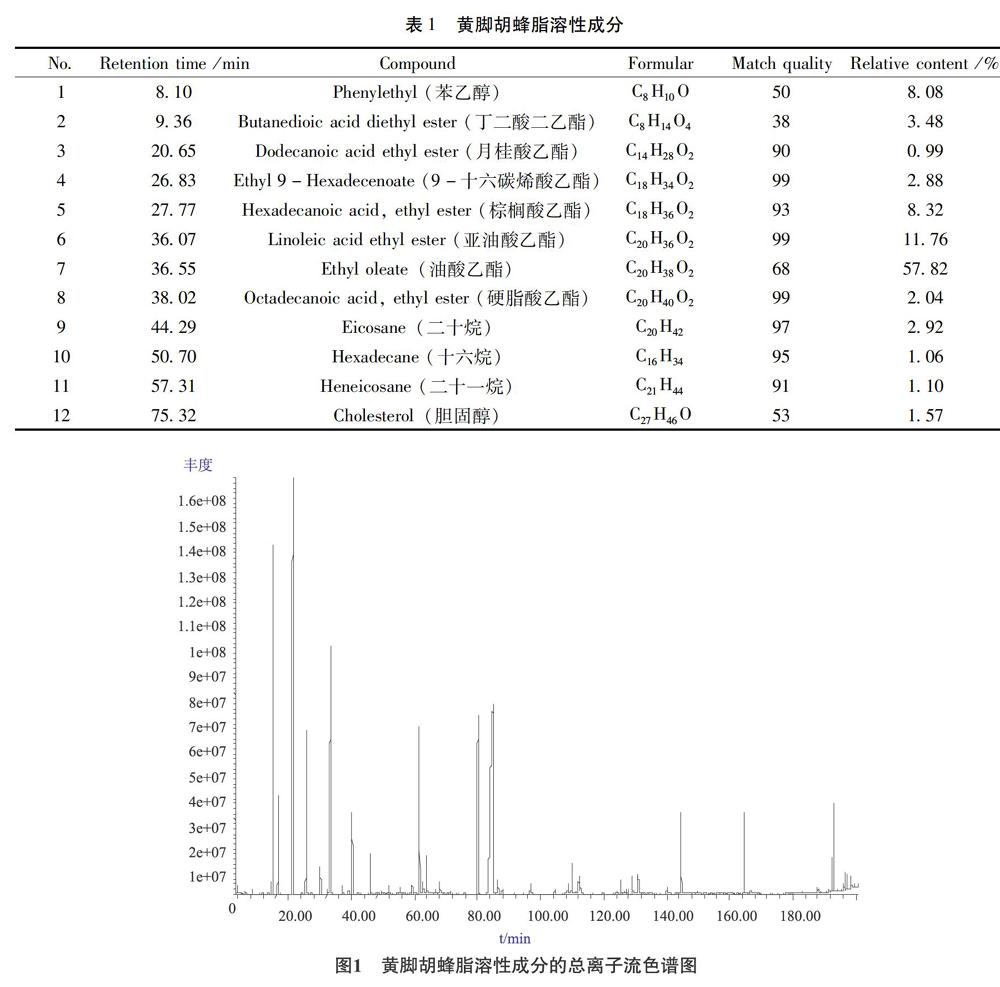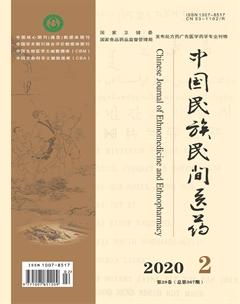黄脚胡蜂脂溶性成分的GC-MS分析
张延智 吴金洪 缪菊连

【摘 要】 目的:测定黄脚胡蜂的脂溶性成分的组成。方法:采用浸渍法提取脂溶性成分,并用气相色谱-质谱联用仪检测其化学成分。结果:从黄脚胡蜂脂溶性成分中鉴定了12个化合物,其主要成分为油酸乙酯 (57.82%)、亚油酸乙酯(11.76%)、棕榈酸乙酯 (8.32%)、苯乙醇 (8.08%)、丁二酸二乙酯 (3.48%)。结论:黄脚胡蜂的脂溶性成分中含量较高的亚油酸乙酯和棕榈酸乙酯具有抗炎的作用,这与云南民间将黄脚胡蜂用酒浸泡后用来治疗佐剂性关节炎和类风湿性关节炎相一致,为民间的用法提供了理论依据。
【关键词】 黄脚胡蜂;脂溶性成分;气相色谱-质谱
【中图分类号】R284.1 【文献标志码】 A 【文章编号】1007-8517(2020)2-0019-03
Abstract:Objective To analyze the chemical constituents in the liposoluble constituents of the Vespa velutina. Method The liposoluble constituents were extracted by the dipping method and their chemical compositions were separated and identified by GC-MS.Result 12 compounds were identified. The liposoluble constituents mainly composed of Ethyl oleate (57.82%), Linoleic acid ethyl ester (11.76%), Hexadecanoic acid ethyl ester (8.32%), Phenylethyl (8.08%), Butanedioic acid diethyl ester (3.48%). Conclusion It demonstrated that the linoleic acid ethyl ester and hexadecanoic acid ethyl ester of liposoluble constituents from the Vespa velutina had anti-inflammatory effect, and the extract of the Vespa velutina was widely used for the treatment of adjuvant arthritis and rheumatoid arthritis in yunnan. The study provided a theoretical basis for folk usage.
Keywords:Vespa velutina; Liposoluble constituent; GC-MS
胡蜂是膜翅目细腰亚目中胡蜂总科昆虫的统称,世界上已发现的胡蜂有5000多种,我国发现的有200余种[1]。《本草纲目》、《本草纲目彩色药图》记载,胡蜂性状甘、凉、有小毒,主治心腹胀满痛、干呕、轻身益气、祛风、解毒,治雀斑面疮[2-3]。现代研究发现,胡蜂发挥药理作用的物质基础主要是蜂毒多肽(来自黑尾胡蜂、蜜蜂或人工合成),蜂毒多肽具有抗肿瘤 [4-6]、抗菌[7]、抗炎[8]的作用,蜂毒多肽还可以用来治疗动脉粥样硬化[9-10]和帕金森病[11-12]。其中黄脚胡蜂主要分布在云贵川,是养殖较多的一种胡蜂,不仅有较高的食用价值,也有较高的药用价值,云南民间常将黄脚胡蜂用酒浸泡后取其提取物治疗关节炎,文献也报道,蜂毒可以治疗佐剂性关节炎和类风湿性关节炎[13-15]。为了研究黄脚胡蜂提取物治疗关节炎的物质基础是蜂毒还是其他成分,本实验对黄脚胡蜂的脂溶性成分进行检测。
1 材料与仪器
1.1 材料 黄脚胡蜂(Vespa velutina)样品收集于云南省大理市,经我院杨自忠教授鉴定为膜翅目细腰亚目胡蜂科的黄脚胡蜂。乙醇、乙酸乙酯和无水碳酸钠均为国产分析纯。
1.2 仪器 7890A /5975C气相色谱-质谱联用仪 (美国Agilent Technologies公司) 。
2 方法与结果
2.1 样品的制备 将黄脚胡蜂100g置于300mL50%乙醇溶液中,室温下浸渍提取30d,将提取物于30℃下减压蒸馏至无醇味后,用50mL乙酸乙酯萃取,萃取物中加入少许无水碳酸钠进行干燥,测定前用微孔滤膜过滤,备用。
2.2 GC-MS分析条件 色谱柱: Agilent气相色谱柱 (Agilent 19091S-433,30m×250μm×0. 25μm) ;程序升温:起始温度为70℃,保持3min,以8℃ /min升至170℃,再以1℃ /min升至220℃,最后以8℃ /min升至300℃。质谱条件:载气为高纯氦气,流速:1. 0mL /min;分流比:10∶[KG-*3/5]1;进样量1. 0μL。EI 离子源,离子源温度230℃,电离能量 70eV;扫描质量范围:50~550amu。采用 NIST11. L 标准谱图库进行检索。
2.3 实验结果 利用上述GC-MS条件进行分析,得到黄脚胡蜂脂溶性成分的总离子流色谱图,如图1所示。所得各组分的质谱数据经NIST11. L 标准谱图库及人工谱图解析,确定其化学成分,各成分的相对百分含量采用峰面积归一化法进行计算,结果见表1。
从黄脚胡蜂脂溶性成分中共检测出18个峰,鉴定了12个化合物,其主要成分为油酸乙酯 (57.82%)、亚油酸乙酯(11.76%)、棕榈酸乙酯 (8.32%)、苯乙醇 (8.08%)、丁二酸二乙酯 (3.48%)。在已鉴定的组分中,酯类占58.33%,烷烃占25.00%,醇類占16.67%。
3 讨论
实验结果表明,黄脚胡蜂脂溶性成分主要是酯、烷烃和醇等物质。含量较高的亚油酸乙酯和棕榈酸乙酯具有抗炎的作用[16-17],这与云南民间将黄脚胡蜂用酒浸泡后用来治疗佐剂性关节炎和类风湿性关节炎相一致,为民间的用法提供了理论依据。而文献报道蜂毒可以治疗关节炎[8],而民间广泛使用的黄脚胡蜂提取物治疗关节炎,究竟是其中的蜂毒发挥作用还是蜂毒与其他成分(例如亚油酸乙酯和棕榈酸乙酯)协同作用的结果还需进一步研究。
参考文献
[1]王滢,张广求,屈睿,等. 黑尾胡蜂毒液抗菌肽的分离纯化及功能研究[J]. 云南民族大学学报:自然科学版,2015,24(2):119-122.
[2]李时珍.本草纲目[M].重庆:重庆大学出版社,1994.
[3]邱德文,吴家荣,夏同珩.本草纲目彩色药图[M].贵阳:贵州科技出版社,1998.
[4]Haiyang Hu, Dawei Chen, Yanfeng Li, et al. Effect of polypeptides in bee venom on growth inhibition and apoptosis induction of the human hepatoma cell line SMMC-7721 in-vitro and Balb/c nude mice in-vivo [J]. Journal of Pharmacy and Pharmacology,2006(58):83-89.
[5]刘淑君,杨勇,傅继华.蜂毒素治疗肝癌的机制及相关制剂研究进展[J]. 药学研究,2014,33(3):162-166.
[6]Soman N.R., Baldwin S.L., Hu G., et al. Molecularly targeted nanocarriers deliver the cytolytic peptide melittin specifically to tumor cells in mice, reducing tumor growth [J]. Journal of Clinical Investigation,2009(119):2830-2842.
[7]Ahmed Hegazi, Amr M. Abdou, Sherein I. Abd El-Moez, et al. Evaluation of the antibacterial activity of bee venom from different sources[J]. World Applied Sciences Journal,2014,30(3):266-270.
[8]Young bae Kwona, Jae dong Leeb, Hye jung Lee, et al. Bee venom injection into an acupuncture point reduces arthritis associated edema and nociceptive responses [J].Pain,2001(90):271-280.
[9]Son D.J., Kang J., Kim T.J., et al. Melittin, a major bioactive component of bee venom toxin, inhibits PDGF receptor beta-tyrosine phosphorylation and downstream intracellular signal transduction in rat aortic vascular smooth muscle cells [J]. Journal of Toxicology and Environmental Health Part A,2007(70):1350-1355.
[10]Kim S.J., Park J.H., Kim K.H., et al. Melittin inhibits atherosclerosis in LPS/high-fat treated mice through atheroprotective actions [J]. Journal of Atherosclerosis and Thrombosis,2011(18):1117-1126.
[11]Doo A.R., Kim S.T., Kim S.N., et al. Neuroprotective effects of bee venom pharmaceutical acupuncture in acute 1-methyl-4-phenyl-1,2,3,6-tetrahydropyridine-induced mouse model of Parkinsons disease [J]. Neurological Research, 2010(32):88-91.
[12]Kim J.I., Yang E.J., Lee M.S., et al. Bee venom reduces neuroinflammation in the MPTP-induced model of Parkinsons disease[J]. International Journal of Neuroscience,2011(121):209-217.
[13]Young Bae Kwon, Hye Jung Lee, Ho Jae Han, et al.The water-soluble fraction of bee venom produces antinociceptive and anti-inflammatory effects on rheumatoid arthritis in rats [J]. Life Sciences,2002(71):191-204.
[14]程林兵,龔雁,王金胜,等.蜂毒制剂“神蜂精”对佐剂性关节炎大鼠血管表皮生长因子及其受体的影响[J].中国蜂业,2015(66):47-50.
[15]谭宁,王科澎,贺守第,等.蜂毒注射液对类风湿关节炎成纤维样滑膜细胞凋亡影响的研究[J].新中医,2015,47(6):280-283.
[16]刘国栋,辛兵,黄栋,等.亚油酸乙酯抑制钛颗粒诱导的炎症反应及其作用机制[J].中国组织工程研究,2016,20(52):7836-7843.
[17]Noha M. Saeed, Ebtehal El-Demerdash, Hanaa M. Abdel-Rahman,et al. Anti-inflammatory activity of methyl palmitate and ethyl palmitate in different experimental rat models[J]. Toxicology and Applied Pharmacology,2012(264):84-93.
(收稿日期:2019-11-03 编辑:陶希睿)

